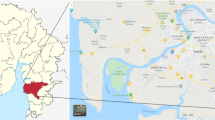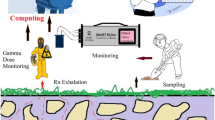Abstract
The health hazards of the radioactive gas radon on the humans are well known. Radon from soil gas is the main cause of radon problems. The “can technique” using LR-115 type II plastic track detectors have been used for the measurement of radon exhalation rate in soil samples from areas of northern Rajasthan, India. The radon exhalation values were calculated in terms of mass (EM) and area (EA). The mass exhalation rate in these samples vary from 8.27 to 23.19 mBq kg−1 h−1 with an average of 14.96 mBq kg−1 h−1, whereas, surface exhalation rate vary from 273.80 to 768.04 mBq m−2 h−1 with an average of 495.32 mBq m−2 h−1. The radium concentration ranges from 6.88 to 19.31 Bq kg−1 with an average value of 12.45 Bq kg−1. The observed values of effective radium concentration in all the soil samples are less than the permissible value of 370 Bq kg−1 as recommended by Organization for Economic Cooperation and Development (OECD). Hence, the result shows that this area is safe as for as the health hazard effects of radium and radon exhalation rate are concerned.
Similar content being viewed by others
References
Abu Jarad, F. (1988) Application of nuclear track detectors for radon related measurements. Nucl. Tracks Radiat. Meas., v.15, pp.525–534.
Alter, H.W. and Prince, P.B. (1972) Radon detection using track registration material, U.S. Patent 3, 665, 194. Terradex Corp.
Azam, A., Naqvi, A.H. and Srivastava, D.S. (1995) Radium concentration and radon exhalation measurements using LR-115 type II plastic track detectors. Nucl. Geophys., v.9, pp.653–657.
Chauhan, R.P. and Chakarvarti, S.K. (2002) Radon diffusion through soil and fly ash: effect of compaction. Radiat. Meas., v.35, pp.143–146.
Chauhan, R.P., Chauhan, P., Pundir, A., Kamboj, S., Bansal, V. and Saini, R.S. (2013) Estimation of dose contribution from 226Ra, 232Th and 40K and radon exhalation rates in soil samples from Shivalik foot hills in India. Radiat. Prot. Dosim., v.158(1), pp.79–86.
Duggal, V., Rani, A. and Mehra, R. (2013) Measurement of indoor radon concentration and assessment of doses in different districts of Northern Rajasthan, India. Indoor Built Environ., pp.1–9. DOI:10.1177/1420326X13500801
Duggal, V., Rani, A., Mehra, R. and Ramola, R.C. (2014) Assessment of natural radioactivity levels and associated dose rates in soil samples from Northern Rajasthan, India. Radiat. Prot. Dosim., v.158(2), pp.235–240.
Folkerts, K.H., Keller, G. and Muth, R. (1984) An experimental study of diffusion and exhalation of 222Rn and 220Rn from building materials. Radiat. Prot. Dosim., v.9, pp.27–34.
Henshaw, D.L., Eatough, J.P. and Richardson, R.B. (1990) Radon as a causative factor in induction of myeloid leukaemia and other cancers. Lancet, v.355, pp.1008–1015.
INTERNATIONAL AGENCY FOR RESEARCH ONCANCER (1988) Monographs on the evaluation of carcinogenic risks to humans. Man Made Mineral Fibres and Radon. IARC Scientific Publ., v.43, pp.173–259.
Khan, A.J., Prasad, R. and Tyagi, R.K. (1992) Measurement of radon exhalation rate from some building materials. Nucl. Tracks Radiat. Meas., v.20, pp.609–610.
Mehra, R., Kumar, S., Sonkawade, R., Singh, N.P. and Badhan, K. (2010) Analysis of terrestrial naturally occurring radionuclides in soil samples from some areas of Sirsa District of Haryana, India using Gamma Ray Spectrometry. Environ. Earth Sci., v.59, pp.1159–1164.
Mehra, R., Singh, S. and Singh, K. (2006) A study of uranium, radium, radon exhalation rate and indoor radon in the environs of some areas of the Malwa region, Punjab. Indoor Built Environ., v.15, pp.499–505.
Mehra, R., Singh, S., Singh, K. and Sonkawade, R.G. (2007) 226Ra, 232Th and 40K analysis in soil samples from some areas of Malwa region, Punjab, India using gamma ray spectrometry. Environ. Monit. Assess., v.134, pp.333–342.
Nagaraju, P., Ray, L., Ravi, G., Akkiraju, V.V. and Roy, S. (2012) Geothermal investigation in the upper Vindhyan sedimentary rocks of Shivpuri area, Central India. Jour. Geol. Soc. India, v.80, pp.39–47.
ORGANIZATION FOR ECONOMIC COOPERATION AND DEVELOPMENT (1979) Exposure to radiation from the natural radioactivity in building materials. Report by a group of Experts of the OECD Nuclear Energy Agency.
Prasad, Y., Prasad, G., Gusain, G.S., Choubey, V.M. and Ramola, R.C. (2008) Radon exhalation rate from soil samples of South Kumaun Lesser Himalayas, India. Radiation Measurements, v.43, pp.369–374.
Ramachandran, T.V. and Subba Ramu, M.C. (1989) Estimation of indoor radiation exposure from the natural radioactivity content of building materials. Oncology, v.3, pp.20–25.
Ramola, R.C. and Choubey, V. M. (2003) Measurement of radon exhalation rate from soil samples of Garhwal Himalaya, India. Jour. Radioanal. Nucl., v.256, pp.219–223.
Rani, A., Mehra, R. and Duggal, V. (2013) Radon monitoring in groundwater samples from some areas of Northern Rajasthan, India using a RAD7 detector. Radiat. Prot. Dosim., v.153, pp.496–501.
Rani, A. and Singh, S. (2005) Natural radioactivity levels in soil samples from some areas of Himachal Pradesh, India using gamma-ray spectrometry. Atmos. Environ., v.39, pp.6306–6314.
Ravikumar, P., Davis, D., Mathew, M., Somashekar, R.K., and Prakash, K.L. (2014) Spatio-temporal variation in radon concentration in groundwater with respect to rock types: A case study from Chitradurga district, Karnataka. Jour. Geol. Soc. India, v.83, pp.156–64.
Sharma, D.K., Kumar, A., Kumar, M. and Singh, S. (2003) Study of uranium, radium and radon exhalation rate in soil samples from some areas of Kangra district, Himachal Pradesh, India using soild-state nuclear track detectors. Radiat. Meas., v.36, pp.363–366.
Singh, H., Singh, J., Singh, S. and Bajwa, B.S. (2008) Radon exhalation rate and uranium estimation study of some soil and rock samples from Tusham ring complex, India using SSNTD technique. Radiat. Meas., v.43, pp.459–462.
Singh, S., Kumar, M. and Mahajan, R.K. (2005) The study of indoor radon in dwellings of Bathinda district, Punjab, India and its correlation with uranium and radon exhalation rate in soil. Radiat. Meas., v.39, pp.535–542.
Singh, S., Rani, A. and Mahajan, R.K. (2005) 226Ra, 232Th and 40K analysis in soil samples from some areas of Punjab and Himachal Pradesh, India using gamma-ray spectrometry. Radiat. Meas., v.39, pp.431–439.
Singh, S., Sharma, D. K., Dhar, S., Kumar, A. and Kumar, A. (2007) Uranium, radium and radon measurements in the environs of Nurpur area, Himachal Himalayas, India. Environ. Monit. Assess., v.128, pp.301–309.
Somogyi, G. (1990) The environmental behaviour of radium. Technical Reports Series No.30, Vol.1, IAEA, Vienna, pp.229–256.
Subba Ramu, M.C., Muraleedharan, T.S. and Ramachandran, T.V. (1988) Calibration of a solid state nuclear track detector for the measurement of indoor levels of radon and its daughters. Science of the Total Environ., v.73, pp.245.
UNSCEAR (1982) United Nations Scientific Committee on the effect of Atomic Radiation, ionizing radiation sources and biological effects. UN, New York.
UNITED NATIONS SCIENTIFIC COMMITTEE ONTHE EFFECTS OFATOMIC RADIATION (2000) Sources and effects of ionizing radiation. Report to the General Assembly with Scientific Annexes. Vol. 1, Annex B: Exposure from natural radiation sources. United Nations.
Yang, T.F., Chau, C.Y., Chen, C-H, Chyi, L.L. and Jiang, J.H. (2003) Exhalation of radon and its carrier gases in SW Taiwan. Radiat. Meas., v.36, pp.425–429.
Author information
Authors and Affiliations
Corresponding author
Rights and permissions
About this article
Cite this article
Duggal, V., Mehra, R. & Rani, A. Study of radium and radon exhalation rate in soil samples from areas of northern Rajasthan. J Geol Soc India 86, 331–336 (2015). https://doi.org/10.1007/s12594-015-0319-z
Received:
Accepted:
Published:
Issue Date:
DOI: https://doi.org/10.1007/s12594-015-0319-z




